For perfect sunbaked brownies, you'll need to master key pan techniques. Start with an aluminized steel or ceramic pan with Thermolon™ coating for excellent heat distribution. Position your pan on a sturdy, level surface away from direct sunlight, using a double-wall construction to maintain even temperatures. Reduce your recipe's liquid content by 25% on humid days, and create a reflective foil collar to protect edges from over-browning. You'll want to monitor closely, starting checks 5-10 minutes before expected completion. Use dark-coated pans at lower temperatures, and always incorporate a moisture-lock design for that ideal fudgy center. These essential strategies only scratch the surface of solar baking mastery.
Double-Layer Pan Heat Distribution
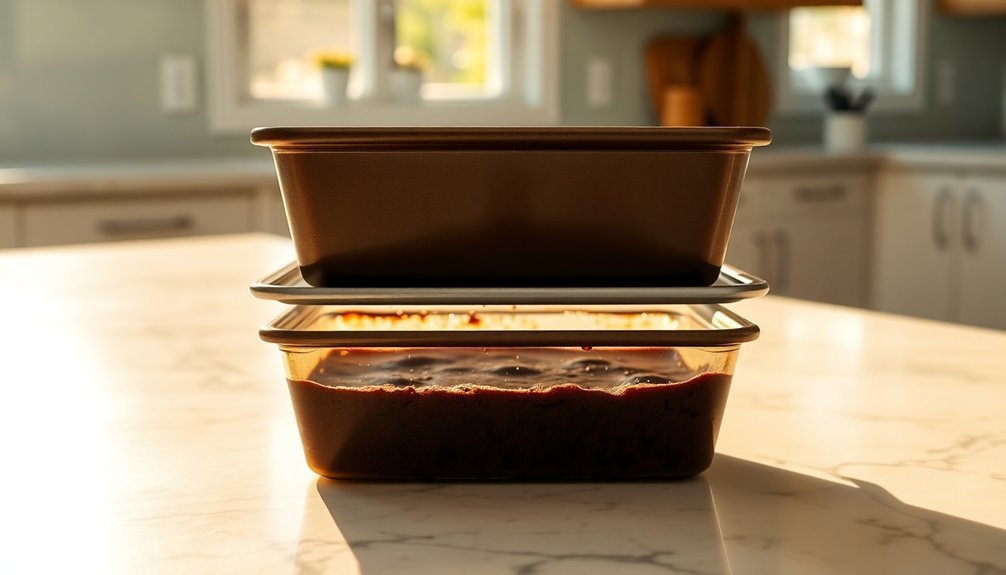
When selecting a double-layer brownie pan, the material composition plays a crucial role in heat distribution.
You'll find aluminized steel offers efficient heat conduction while resisting warping and rusting up to 450°F. Aluminum heats quickly and maintains consistent temperatures, though dark-coated versions transfer heat more aggressively to your brownies.
Consider carbon steel with nonstick coating or ceramic if you need higher temperature tolerance, as both can handle up to 520°F while providing excellent heat diffusion. Burgundian clay construction makes ceramic options particularly resistant to extreme temperature changes.
These materials also resist thermal shock, ensuring your pan won't warp during temperature changes.
Avoid glass pans, as they'll likely leave you with undercooked centers and overbrowned edges.
For ideal results, stick with metal-based options that promote even heating throughout your brownies' baking process.
Reflective Foil Collar Setup
Three key steps make up an effective foil collar setup for your brownie pan.
First, measure and cut aluminum foil that's 3-6 inches longer than your pan's circumference, then fold it lengthwise for easier handling.
Second, grease one side of the foil to help it stick to the pan's sides.
Wrap the collar around your pan so it extends above the rim, and secure the overlapping ends by folding them together or using string below the pan's top edge.
You'll want to check that there aren't any gaps or loose sections that could affect your brownies' baking performance.
This collar setup guarantees even heat distribution, prevents edge overcooking, and helps maintain moisture throughout the baking process, resulting in perfectly flat, evenly baked brownies. Similar to how insulated cake strips work, this method ensures the outer edges don't heat faster than the center.
Dark Pan Temperature Control
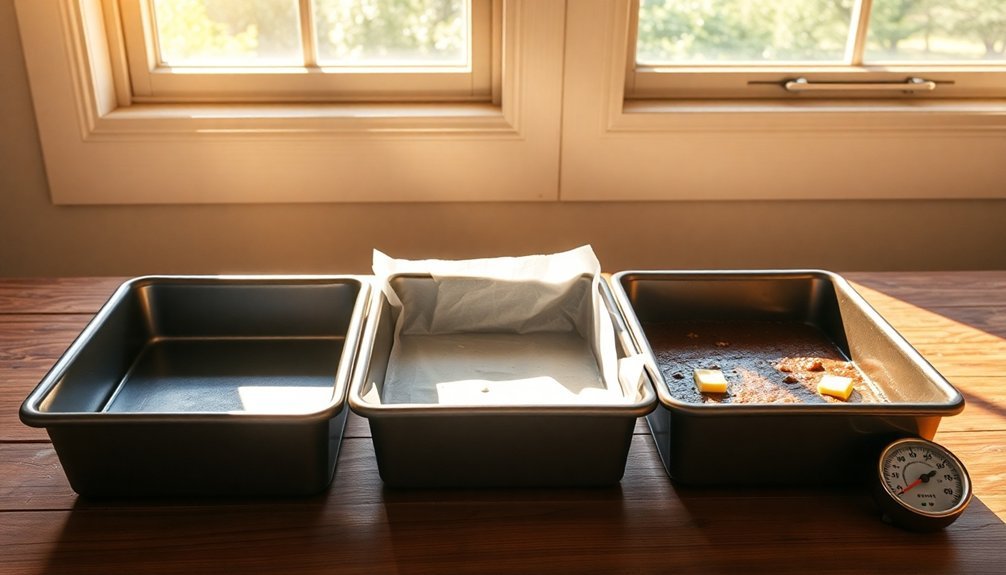
When you're baking with dark pans, you'll need to lower the oven temperature by 25 degrees to prevent over-browning and guarantee even cooking.
You should watch the surface temperature closely, as dark pans absorb and retain more heat than their lighter counterparts.
Since these pans heat up differently, start checking your brownies about 5-10 minutes before the recipe's suggested baking time. For ideal results, always position your brownies on the middle shelf position for the most consistent heat distribution.
Lower Heat When Darkened
Since dark metal pans absorb heat more aggressively than their lighter counterparts, you'll need to modify your oven temperature accordingly.
When using a dark pan, lower your oven temperature by 25 degrees to prevent over-browning and uneven baking. For example, if your recipe calls for 350°F, set your oven to 325°F instead.
You'll notice your brownies will bake faster in dark pans, so start checking for doneness about 5-10 minutes earlier than the recipe suggests. A cake that typically takes 50 minutes might be ready in just 45 minutes.
Using an oven thermometer will help ensure your adjusted temperature stays accurate throughout baking.
Don't rely solely on the timer – keep an eye on your baked goods and use a toothpick test to ascertain they're properly cooked. This temperature adjustment helps achieve a tender crust and prevents the edges from setting before the center is done.
Monitor Surface Temperature Carefully
Monitoring your dark pan's surface temperature is essential for achieving perfectly baked brownies. Since dark pans absorb and distribute heat more quickly than lighter ones, you'll need to watch them carefully to prevent overcooked edges and undercooked centers.
Check your brownies 5-10 minutes before the recipe's suggested baking time, and use an oven thermometer to maintain precise temperature control.
- Don't let your dream of gooey, perfect brownies turn into a burnt disappointment
- Say goodbye to the frustration of crusty edges and raw middles
- Transform your baking from guesswork into confident precision
Remember to adjust your oven temperature downward when using dark pans, and monitor the internal temperature until it reaches 180 degrees.
The pan's intense heat absorption means your brownies will continue cooking even after you've removed them from the oven.
Adjust Baking Time Accordingly
The right baking time makes all the difference when using dark pans for your brownies. Since dark pans absorb heat more quickly than light ones, you'll need to adjust your approach.
Start by reducing your oven temperature by 25 degrees – if your recipe calls for 350°F, set it to 325°F instead.
You'll want to check your brownies 5-10 minutes earlier than the recipe suggests, as they'll likely bake faster in a dark pan. For instance, if your recipe normally takes an hour at 350°F, start checking at around 45 minutes when baking at 325°F.
Don't rely on timing alone – use a thermometer to check if the internal temperature has reached 180 degrees, or insert a skewer to test for doneness.
Solar-Safe Pan Materials
When choosing brownie pans for solar cooking, materials play a crucial role in both performance and safety.
Ceramic pans with Thermolon™ coating offer an eco-friendly option that's safe up to 850°F, while aluminized steel provides quick, uniform heating that's perfect for achieving those crispy edges.
Porcelain pans, though slower to heat, excel at heat retention and feature attractive designs that'll make your solar-baked treats look stunning.
- Experience the satisfaction of baking with cast iron's time-tested durability, knowing your pan will serve generations.
- Feel good about using ceramic's non-toxic, sand-derived materials that keep your family safe.
- Enjoy the convenience of porcelain's quick-release technology, making cleanup a breeze.
Choose carbon steel or cast iron if you're looking for versatile, eco-conscious options that'll last decades with proper care.
Heat Retention Pan Techniques
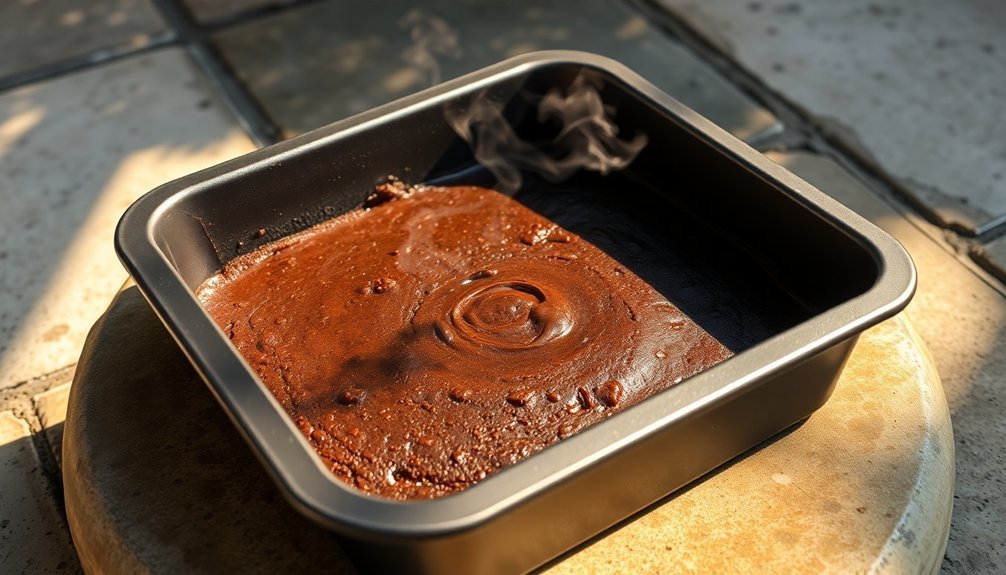
Successfully managing heat retention in brownie pans requires understanding how different materials respond to temperature changes.
You'll find that aluminized steel and carbon steel pans heat quickly and maintain consistent temperatures, making them ideal for evenly baked brownies.
If you're using cast iron, you'll need to properly season it first, but you'll be rewarded with superior heat retention and the ability to withstand temperatures up to 500°F.
Porcelain pans heat more slowly but hold heat well, perfect for gooey brownies.
When using dark pans, reduce your oven temperature by 25°F to prevent over-browning.
For best results, preheat your pan and consider using heating cores for larger batches.
Remember to maintain your pan's nonstick coating by hand washing and avoiding metal utensils.
Moisture Lock Pan Design
You'll find the moisture lock pan's silicone seal technology creates an airtight barrier that traps essential moisture during baking.
The double-wall heat distribution system works in tandem with the seal to maintain consistent temperatures throughout the cooking process.
These innovative features combine to produce perfectly textured brownies with that sought-after balance of crispy edges and moist centers.
Silicone Seal Technology
Through innovative moisture-lock technology, silicone seals transform ordinary brownie pans into precision baking tools. You'll notice the surgical stainless steel construction, combined with an aluminum core, creates perfect heat distribution for your sunbaked treats.
The non-porous surface and roll-bonding process guarantee your brownies cook evenly while retaining essential moisture and nutrients.
- Feel confident knowing you're baking with eco-friendly, non-toxic materials that keep your family safe
- Experience the joy of perfectly moist brownies every time, thanks to the advanced sealing technology
- Save energy and time with efficient, stack-cooking capabilities that make baking a breeze
The stay-cool handles and medium-to-low temperature cooking method give you complete control over your baking process, while the silicone seal locks in flavors without requiring additional oils or fats.
Double-Wall Heat Distribution
Modern double-wall heat distribution combines precision engineering with advanced materials to revolutionize brownie baking.
You'll find that aluminum and aluminized steel pans offer superior heat conductivity, warming up quickly to guarantee your batter bakes evenly throughout.
While square pans remain the traditional choice for perfect edges, you can explore intermediate conic shapes that optimize heat distribution in your home oven.
If you're using a porcelain pan, you'll need to allow extra time for initial heating, but it'll maintain consistent temperature throughout baking.
For the best results, consider pans with textured nonstick coatings – they'll enhance air circulation while preventing your brownies from sticking.
Dark nonstick surfaces, like those found in Chicago Metallic pans, retain more heat than their lighter counterparts, giving you better control over baking times.
Pan Position For Solar Exposure
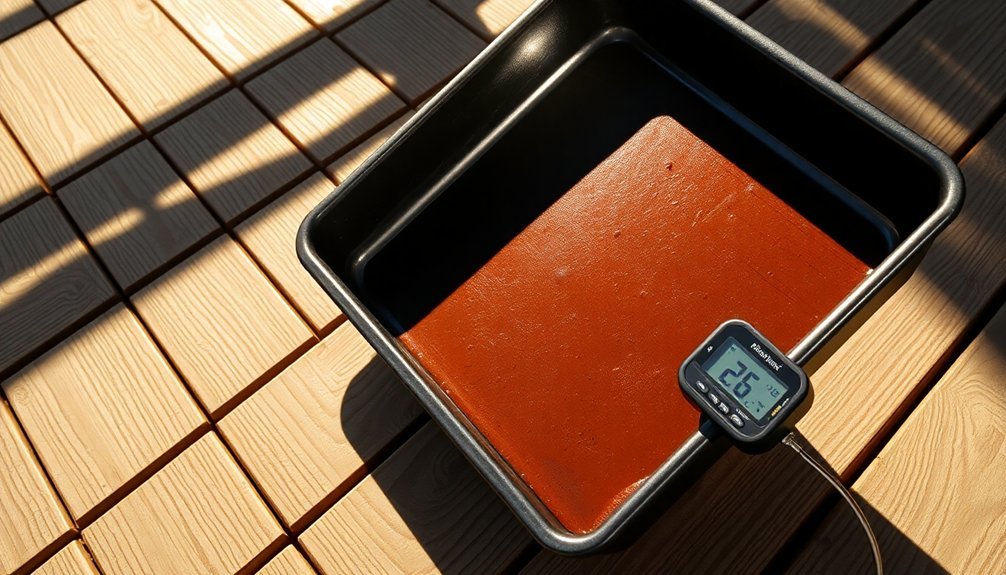
While solar exposure might seem irrelevant for conventional oven baking, it's crucial to take into account when storing your brownie pan before and during preparation.
Direct sunlight can heat your pan unevenly, especially if you're using dark metal or glass pans. You'll want to keep your baking equipment in a cool, shaded area of your kitchen to maintain consistent temperatures before you begin baking.
- Feel confident knowing your brownies will bake evenly when starting with a properly temperature-controlled pan
- Rest assured your nonstick coating won't deteriorate from prolonged sun exposure
- Trust that your perfectly prepared pan will deliver the fudgy, delicious results you're craving
Remember to position your cooling rack away from windows to prevent uneven setting as your brownies cool, which could affect their final texture and consistency.
Portable Pan Support Systems
Selecting the right portable pan support system can transform your brownie-making experience, especially when baking away from your usual kitchen setup.
You'll want a support system that locks securely to your portable burner while accommodating various pan sizes.
Look for a foldable support system that's compatible with your cooking equipment. The best options feature sturdy flanges that provide stable support while folding easily for compact storage.
You'll find systems that fit neatly inside your cooking cups, saving valuable space in your gear.
When choosing a support system, guarantee it's built to withstand outdoor conditions. The attachment mechanism should be simple to operate, letting you quickly set up and adjust your brownie pan.
Consider systems that work with both specialized cookware and traditional pans for maximum versatility.
Sun-Tracking Pan Adjustment Methods
You'll want to position your brownie pan at an angle that matches your latitude minus 15 degrees during summer months, or plus 15 degrees in winter, to capture ideal sunlight exposure.
By rotating your pan every 15-20 minutes like a single-axis tracker, you can guarantee even browning across the entire surface.
If manual adjustments aren't practical, you can set up a simple timed rotation schedule that follows the sun's daily east-to-west path.
Optimal Pan Angle Positioning
Despite the technicality of "sun-tracking" and "pan angle positioning" in other contexts, these concepts don't apply to brownie baking. Instead, you'll want to focus on proper pan selection and preparation techniques that'll yield the best results.
Choose a pan with adequate weight for even heat distribution, and consider using parchment paper for easy removal.
- You'll feel a sense of accomplishment when your brownies release effortlessly from a well-prepared pan.
- You'll experience the satisfaction of achieving that perfect crackly top through proper egg and sugar beating.
- You'll enjoy the pride of serving perfectly textured brownies with clean, professional-looking cuts.
Remember to adjust your baking time and temperature based on your pan's material, and always check for doneness before the suggested baking time ends.
Darker metal pans require shorter baking times to prevent over-browning.
Rotating For Even Exposure
While automated solar tracking systems employ sophisticated algorithms, brownie pan rotation requires a much simpler approach for even baking.
You'll want to rotate your pan 180 degrees halfway through the baking time to guarantee uniform exposure to the sun's rays, similar to how ground-mounted solar panels are adjusted for ideal exposure.
For the best results, you can make smaller adjustments every 30 minutes, just as solar arrays use periodic sampling to maximize output.
Position your pan at an angle that matches your latitude, then add 15° during winter months and subtract 15° during summer months.
If you're using multiple pans, arrange them like dual-axis solar panels, ensuring each pan has unobstructed exposure to sunlight.
Remember to avoid metal utensils on aluminized steel pans to protect their coating.
Weather-Ready Pan Protection Strategies
Since weather conditions can greatly impact brownie baking, protecting your pan and implementing proper techniques becomes essential for consistent results. Line your pan with parchment paper, creating a sling that extends over the sides, and secure it by folding over the handles.
You'll want to reduce liquid ingredients by about a quarter during humid days and use a water meter for precise moisture control.
- Save your precious brownies from the heartbreak of sticking with high-quality aluminized steel or aluminum pans
- Give your treats the gift of perfect texture by avoiding glass pans that can betray you with uneven baking
- Shield your masterpiece from summer's harsh humidity by storing in airtight containers
Remember to cool your brownies in a controlled environment and maintain your nonstick pans by hand-washing them instead of using the dishwasher.
Frequently Asked Questions
Can I Use Disposable Aluminum Pans for Sun-Baked Brownies?
Yes, you'll find disposable aluminum pans perfect for sun-baked brownies. They conduct heat efficiently, distribute it evenly throughout your batter, and you won't need to worry about cleanup afterward – just toss them when done.
How Do I Prevent Condensation From Forming Under the Pan Cover?
Place a paper towel under your pan's cover to absorb moisture. Don't let it touch the brownies' surface. You can also wrap the pan with plastic wrap first, allowing condensation to form on the wrap instead.
What's the Ideal Pan Color for Maximizing Solar Heat Absorption?
You'll want to use black or dark-colored pans for maximum solar heat absorption. They're most effective at capturing and retaining solar energy. Dark blue, brown, or dark green pans will also work well.
Should I Rotate the Pan Differently at Different Times of Day?
No, you don't need to rotate pans differently at different times of day. The basic principle of rotating halfway through baking remains constant, as it's about evening out hot spots in your oven.
Can I Stack Multiple Pans to Achieve Different Brownie Textures?
You shouldn't stack multiple brownie pans as it'll cause uneven heating and poor air circulation. Instead, adjust your baking time, ingredient ratios, or try different add-ins to achieve varying textures.
In Summary
You'll find these pan techniques transform your solar baking experience. Whether you're using double-layer distribution or tracking the sun's movement, proper pan selection and setup make all the difference in achieving perfect sunbaked brownies. Don't forget to protect your setup from unexpected weather changes. With these methods mastered, you're ready to create delicious, evenly baked treats using nothing but the sun's natural energy.
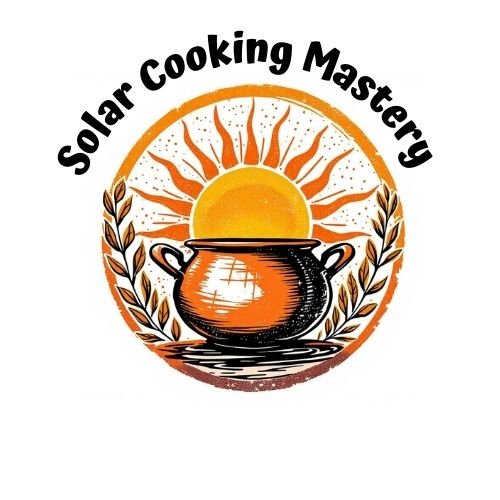
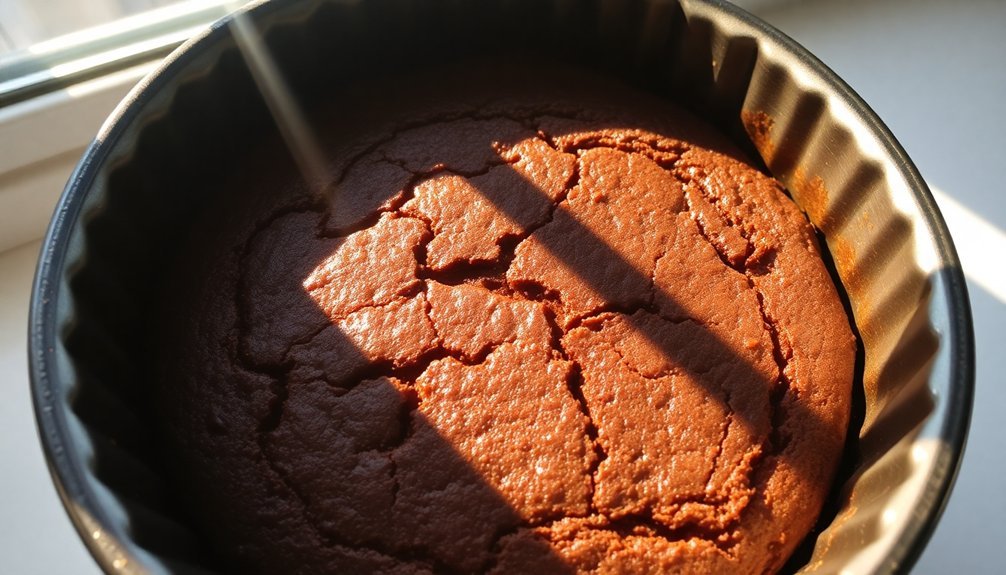
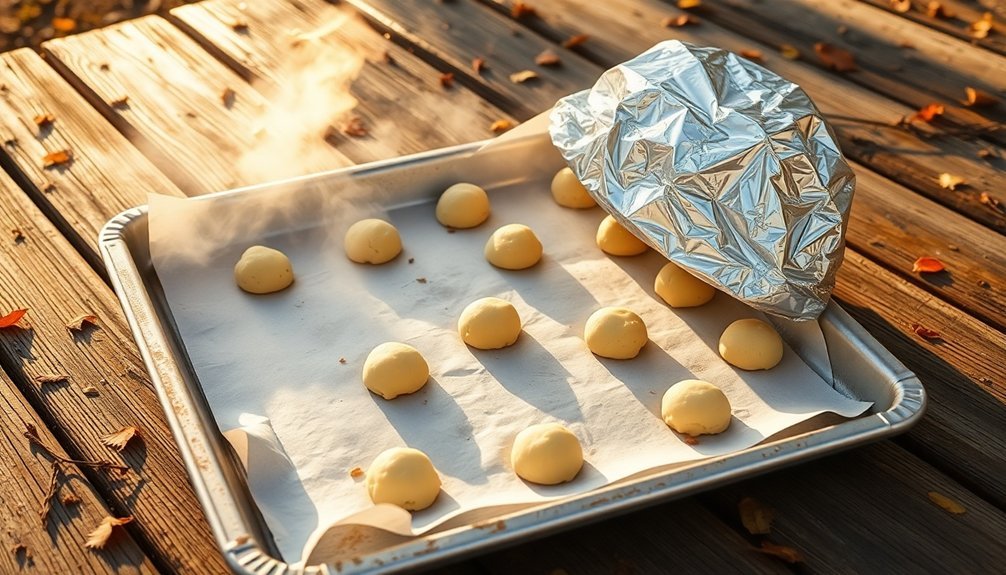
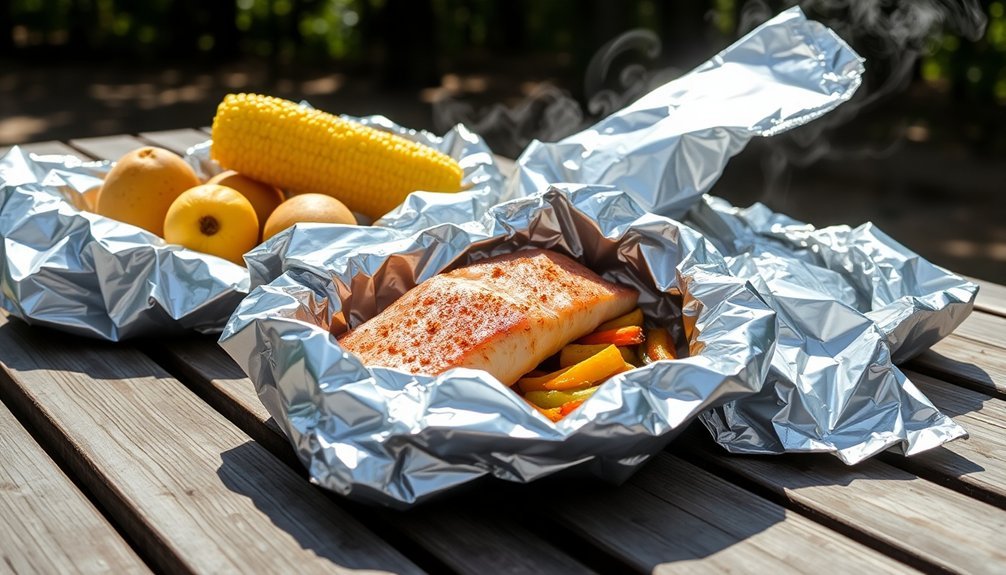
Leave a Reply